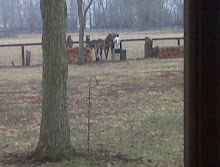
After my trip last week, I am giving serious thought to leasing a local farm with 70 acres, a house, and a few barns to do some 'experimentation' on my own.
There will be no formal training track per se, as I will ship 1x-2x a week to a nearby facility for speedwork, but I will have several gallops of varying lengths and inclines, in addition to a host of other 'toys' designed to improve conditioning.
I am not a horseman, I am an equine exercise physiologist - so I will have someone else in charge of all farrier, vet, and horsemanship stuff - yet I will prescribe and monitor all training variables based on heart rate/GPS data as well as blood lactate levels, following the laws of exercise physiology.
Let's call this Feedback Based Training, where each individual athlete determines his/her own level of progress. No longer will all speedwork be regimented into half mile breezes every Thursday, for instance.
Also:
- horses will work left hand turns and right hand turns equally to develop balance
- horses will warm up and cool down extensively
- training hours will be from 6am to 6pm when weather permits
- horses will be turned out frequently, especially after racing, to speed recovery
- nutrition will be monitored to the calorie
- owners will be provided with all data indicating progress/development
- as little veterinary interference as possible, unsound horses will not run/train
Should be fun! - I will no doubt publish any and all findings in this space for you to review and/or comment on. I hope to be up and operational within late 2010 - should all go well.




